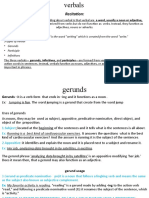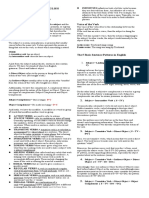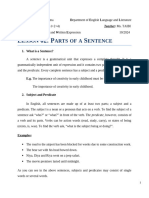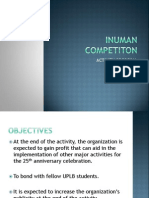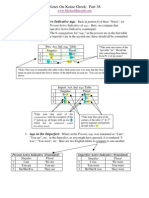Subject and Verbs
Subject and Verbs
Uploaded by
Leah Marie SernalCopyright:
Available Formats
Subject and Verbs
Subject and Verbs
Uploaded by
Leah Marie SernalCopyright
Available Formats
Share this document
Did you find this document useful?
Is this content inappropriate?
Copyright:
Available Formats
Subject and Verbs
Subject and Verbs
Uploaded by
Leah Marie SernalCopyright:
Available Formats
Subject Verb Being Adverb of Time or Place In the English language, there are ten basic sentence patterns
according to the type of verb used. The verb of being is followed by an adverb of time or place. Adverbs are words that describe a verb, an adjective, or another adverb. Examples of verbs of being: is are was has been have been had been
Pattern 1-1: Adverbs of time or place indicate when or where I was here last week.
Pattern 1-2: The adverb of time or place as a prepositional phrase My friends are at the office. Subject Verb of Being Adjective The verb of being is followed by an adjective. Adjectives are words that describe the subject. Examples of verbs of being: is are was has been have been had been
Pattern 2-1: Subject + V-be + ADJ The boy is very enthusiastic. Pattern 2-2: Subject + V-be + ADJ Her voice was quite lovely. Subject Be Verb Subjective Complement (Noun) The verb of being is followed by a noun that describes the subject (subjective complement). Examples of verbs of being: is are was has been have been had been
Pattern 3: Subject + V-be + Subj. Comp. I have been a student for twenty years. The subjective complement has the same numerical designation as the subject because the two are actually the same (i.e. I = student).
Subject + Linking Verb + Subjective Complement (Adj) The linking verb is followed by an adjective that describe the subject (subjective complement). Examples of linking verbs: smell taste look feel seem become appear grow
Pattern 4: Subject + LV + ADJ The cake on the table looks delicious. Subject-Linking Verb-Subjective Complement (Noun) The linking verb is followed by a noun functioning as a subjective complement. In this sentence pattern, a linking verb pins or connects a label on the subject. The label that was mentioned earlier is what we call subject complement. Subject Complement (Subj, Comp.) = a phrase that follows a linking verb; it describes or complements the subject. Pattern 5: Subject + LV + Subj. Comp. Example 1: At an early age, I became a violinist. The verbs that can be used in this pattern are the true linking verbs: any form of the verb be [am, is, are, was, were, has been, are being, might have been, etc]. There are also few linking verbs which do not use the be but functions like it. Examples are, seem, look, grow, appear, feel, look, prove, smell, remain, sound, turn and taste. These verbs also function as action verbs. Subject-Verb-Intransitive The action verb does not need not need to have a direct object - - -- that with or without the direct object, the sentence would still be complete. Such action verbs are called intransitive verbs. Most action verbs can be intransitive verbs depending on how they are used in a sentence. Some examples of intransitive verbs: arrive go sneeze lie sit die
Pattern 6: Subject + IV Example 1: My supervisor will arrive. (direct object is not needed) Example 2: My supervisor will arrive by 7:00 pm.
Subject-Transitive Verb-Direct Object The action verb is followed by a direct object. These verbs are called transitive verbs. Some examples are: kick want paint write eat clean To determine if a verb is transitive, ask whom? or what? after the verb. If you can find the answer in the sentence, then the verb is transitive. For example: I saw Johnny Depps latest movie. saw what? Johnny Depps latest movie Therefore, saw is a transitive verb. Pattern 7: S + TV + DO I saw Johnny Depps latest movie.
You might also like
- English Grammar Made EasyDocument17 pagesEnglish Grammar Made EasyAyaz Latif Siyal87% (23)
- Parts of SentencesDocument14 pagesParts of SentencesAkirun Harahap100% (1)
- RULE 110-112 Case DigestDocument7 pagesRULE 110-112 Case DigestLeah Marie Sernal100% (1)
- Ortega vs. SSSDocument2 pagesOrtega vs. SSSLeah Marie Sernal100% (2)
- Cbs Esp 006 Notes PDFDocument11 pagesCbs Esp 006 Notes PDFchdeepak96No ratings yet
- College English ReviewerDocument5 pagesCollege English ReviewervinxrieNo ratings yet
- Lessons 5 and 6 - Verbs PDFDocument28 pagesLessons 5 and 6 - Verbs PDFpedroa.oliv22No ratings yet
- Verbals Week 8 Flinguis 3Document18 pagesVerbals Week 8 Flinguis 3Shane Mendoza BSED ENGLISHNo ratings yet
- Transitive or Intransitive Verbs: Intransitive: The Verb Only Has A SubjectDocument16 pagesTransitive or Intransitive Verbs: Intransitive: The Verb Only Has A Subjectakhilesh sahooNo ratings yet
- GRAMATICADocument5 pagesGRAMATICADI APCNo ratings yet
- The 5 Basic Sentence PatternsDocument6 pagesThe 5 Basic Sentence PatternsShuoNo ratings yet
- Sentence CorrectionDocument10 pagesSentence CorrectionsanjivsingNo ratings yet
- English 111 ReviewerDocument7 pagesEnglish 111 ReviewerCharles IldefonsoNo ratings yet
- Week 9 Grammar in ContextDocument36 pagesWeek 9 Grammar in ContextAina MasriNo ratings yet
- Bahasa Inggris Tugas Nilai Perbaikan Ryu XII IPSDocument3 pagesBahasa Inggris Tugas Nilai Perbaikan Ryu XII IPSUji FcNo ratings yet
- Classification of VerbsDocument5 pagesClassification of Verbssudhakaranct100% (2)
- Verbs Notes (LP)Document3 pagesVerbs Notes (LP)Raven AnonymousNo ratings yet
- The Eight Parts of Speech: NounsDocument17 pagesThe Eight Parts of Speech: NounsValensia SumampouwNo ratings yet
- English 8Document13 pagesEnglish 8farhanieNo ratings yet
- Modals Are Auxiliary or Helping Verbs. They May Be Used in Expressing Permission, Obligation and ProhibitionDocument9 pagesModals Are Auxiliary or Helping Verbs. They May Be Used in Expressing Permission, Obligation and ProhibitionJurelyn Victoria VeranNo ratings yet
- SUMMER Remediation Lingva LATINA VII Grammar I, Ii, Iii: Lessons 1 - 2 - 3Document23 pagesSUMMER Remediation Lingva LATINA VII Grammar I, Ii, Iii: Lessons 1 - 2 - 3Gabriela MccawleyNo ratings yet
- Makalah Bahasa Inggris Ega 4Document16 pagesMakalah Bahasa Inggris Ega 4Sri MursalinaNo ratings yet
- Uses of Active and Passive VoiceDocument4 pagesUses of Active and Passive Voicehimaj42013No ratings yet
- Verbs: Tense, Mood, Voice, EtcDocument5 pagesVerbs: Tense, Mood, Voice, EtcMecislavs GrigorcuksNo ratings yet
- Name: Buya Ahmad Bilal Nim:200502502015 Class: English Educatioan ADocument17 pagesName: Buya Ahmad Bilal Nim:200502502015 Class: English Educatioan ABilal BuyaNo ratings yet
- Sentence TrnsformationDocument30 pagesSentence TrnsformationJoby Bang-asNo ratings yet
- Sentence PatternsDocument5 pagesSentence PatternsQuzalina QuzzNo ratings yet
- English - Make SentencesDocument16 pagesEnglish - Make SentencesRosana LlinasNo ratings yet
- Action Verbs Presentation in Purple Blue Bold Style 1Document56 pagesAction Verbs Presentation in Purple Blue Bold Style 1carinaturnobonito84No ratings yet
- Lee Esto Primero... !Document13 pagesLee Esto Primero... !Orlando Chandía OchoaNo ratings yet
- LLLLLLLLLLLLLLLLLLLLLLLLLLLLLLLFFFFFFFFFFFFF: The Action Verb The Transitive Verb The Intransitive VerbDocument14 pagesLLLLLLLLLLLLLLLLLLLLLLLLLLLLLLLFFFFFFFFFFFFF: The Action Verb The Transitive Verb The Intransitive VerbJamil AhammedNo ratings yet
- The English VerbDocument36 pagesThe English Verball3xutzzaNo ratings yet
- Lesson About Verbs by Kiev B. AlmiraDocument31 pagesLesson About Verbs by Kiev B. AlmiraKiev Barredo AlmiraNo ratings yet
- Structure of EnglishDocument9 pagesStructure of EnglishCherry Mae PalilioNo ratings yet
- English GrammarDocument22 pagesEnglish GrammarMertic Diana100% (1)
- Vo Thi Minh Phu-Verb PhraseDocument19 pagesVo Thi Minh Phu-Verb PhraseHồng NgọcNo ratings yet
- Prelim Grammar Handout - (Functions of Noun, Pronouns & Cases, Verb & Cases)Document21 pagesPrelim Grammar Handout - (Functions of Noun, Pronouns & Cases, Verb & Cases)Chritina kelly BagidNo ratings yet
- Parts of SpeechDocument7 pagesParts of Speechnorain_1976No ratings yet
- English Grammar English Grammar A Short Guide: Graham TullochDocument11 pagesEnglish Grammar English Grammar A Short Guide: Graham TullochNaoufal FouadNo ratings yet
- 4 Main Kinds of VerbsDocument9 pages4 Main Kinds of VerbsJoanne TolzmanNo ratings yet
- Verbs Gerunds and Infinitive FinishDocument10 pagesVerbs Gerunds and Infinitive FinishYoga NurzamanNo ratings yet
- 822 - Cir 253 Grade 10 Pcbo Reference MaterialDocument106 pages822 - Cir 253 Grade 10 Pcbo Reference MaterialPRANIT KANDASAMYNo ratings yet
- English Grammar Basics ManiDocument3 pagesEnglish Grammar Basics Manipmanidhar1234No ratings yet
- Unit 1 - English - WWW - Rgpvnotes.inDocument17 pagesUnit 1 - English - WWW - Rgpvnotes.inabc asassNo ratings yet
- Eng LLB Assignment (Zeeshan Fateh Buriro)Document3 pagesEng LLB Assignment (Zeeshan Fateh Buriro)Meer KhanNo ratings yet
- Prepositional and Phrasal Verb ResearchDocument8 pagesPrepositional and Phrasal Verb ResearchAinalnaem GhidariNo ratings yet
- A Novel Idea Kamilan TakmilDocument77 pagesA Novel Idea Kamilan TakmilSofia RaheelNo ratings yet
- Verb PresentationDocument21 pagesVerb PresentationM Aziz M SharifNo ratings yet
- The Different Types of NounsDocument18 pagesThe Different Types of NounsL.a.ZumárragaNo ratings yet
- Part of Speech Overview: 1. NounDocument39 pagesPart of Speech Overview: 1. NounClarissa KurniadiNo ratings yet
- Parts of A Sentence 1Document7 pagesParts of A Sentence 1sarra BakhtouiNo ratings yet
- English Assignment 1Document22 pagesEnglish Assignment 1katilabbuNo ratings yet
- Classification of Verbs: ObjectivesDocument5 pagesClassification of Verbs: ObjectivesLovely Grace CajegasNo ratings yet
- Classification of Verbs: ObjectivesDocument5 pagesClassification of Verbs: ObjectivesLovely Grace CajegasNo ratings yet
- Sentence Patterns - UBDDocument20 pagesSentence Patterns - UBDbellaobenixNo ratings yet
- Local Media2228404664060191112Document55 pagesLocal Media2228404664060191112audreyedayan6No ratings yet
- Part of Speech - English LessonDocument30 pagesPart of Speech - English LessonAngel SimoNo ratings yet
- Active & Passive VoiceDocument3 pagesActive & Passive VoicebernardbomanNo ratings yet
- TRƯỜNG ĐẠI HỌC KIỂM SÁT HÀ NỘIDocument27 pagesTRƯỜNG ĐẠI HỌC KIỂM SÁT HÀ NỘIvuducngoc23No ratings yet
- Phrase To SentenceDocument54 pagesPhrase To SentencepreciousjulietfelizardoNo ratings yet
- The Four Principal Parts of The VerbDocument12 pagesThe Four Principal Parts of The VerbAriana GarciaNo ratings yet
- Best Parts of SpeechDocument30 pagesBest Parts of SpeechZabi MansooriNo ratings yet
- 7 Days to Grammar Excellence: How to Master English from Beginner to AdvancedFrom Everand7 Days to Grammar Excellence: How to Master English from Beginner to AdvancedNo ratings yet
- Oceaneering Vs BarrettoDocument3 pagesOceaneering Vs BarrettoLeah Marie SernalNo ratings yet
- Admin Case Digest FullDocument53 pagesAdmin Case Digest FullDaisyDianeDeGuzmanNo ratings yet
- KBMBPM Vs DominguezDocument3 pagesKBMBPM Vs DominguezLeah Marie SernalNo ratings yet
- PEZA Citizens CharterDocument159 pagesPEZA Citizens CharterLeah Marie Sernal100% (1)
- Yanson Until Star Paper (37-42)Document8 pagesYanson Until Star Paper (37-42)Leah Marie SernalNo ratings yet
- G.R. No. L-409 January 30, 1947 ANASTACIO LAUREL, Petitioner, ERIBERTO MISA, RespondentDocument12 pagesG.R. No. L-409 January 30, 1947 ANASTACIO LAUREL, Petitioner, ERIBERTO MISA, RespondentLeah Marie SernalNo ratings yet
- Villaber Vs COMELECDocument2 pagesVillaber Vs COMELECLeah Marie Sernal100% (4)
- NTA vs. COADocument1 pageNTA vs. COALeah Marie SernalNo ratings yet
- 4.4 Ong Yiu v. CaDocument2 pages4.4 Ong Yiu v. CaLeah Marie SernalNo ratings yet
- 2.1.5 Bachelor Express v. CADocument2 pages2.1.5 Bachelor Express v. CALeah Marie Sernal100% (4)
- Alpha Vs CaloDocument1 pageAlpha Vs CaloLeah Marie SernalNo ratings yet
- Mikko's ProposalDocument10 pagesMikko's ProposalLeah Marie SernalNo ratings yet
- Tumba HanDocument2 pagesTumba HanLeah Marie SernalNo ratings yet
- Table PermitDocument1 pageTable PermitLeah Marie SernalNo ratings yet
- Tenses Comprehensive StructureDocument4 pagesTenses Comprehensive StructureDivya JainNo ratings yet
- Notes On Koine Greek, Pt. 38Document1 pageNotes On Koine Greek, Pt. 38pisteuomenNo ratings yet
- CronologiaDocument28 pagesCronologiaValerie Angel WoolenNo ratings yet
- English Plus ModuleDocument147 pagesEnglish Plus ModuleMelanie C. MalasagaNo ratings yet
- Relative ClausesDocument20 pagesRelative Clausesmauricio3090No ratings yet
- EN Empresa G2 EL 21-9-2022 - EjerciciosDocument7 pagesEN Empresa G2 EL 21-9-2022 - EjerciciosAxel RAMIEZ PEREZNo ratings yet
- Trac Nghiem PragmaticsDocument13 pagesTrac Nghiem PragmaticsTrung LêNo ratings yet
- AppositivesDocument9 pagesAppositivesOmar CaballeroNo ratings yet
- UNIT 6 - Gerunds and InfinitivesDocument45 pagesUNIT 6 - Gerunds and Infinitivesnguyen anNo ratings yet
- Giáo Trình Writing Level 1Document69 pagesGiáo Trình Writing Level 1tranngiabaoNo ratings yet
- Modals - English Grammar: Can Can Can Can Can CanDocument3 pagesModals - English Grammar: Can Can Can Can Can Cansofiacunha92No ratings yet
- Past Tense Marking in AfrikaansDocument1 pagePast Tense Marking in AfrikaansMarcus Amadeus von BergenNo ratings yet
- Past Simple of Be 4th Grade 2023Document2 pagesPast Simple of Be 4th Grade 2023ritasusanaNo ratings yet
- Cuestionario - Inglés C Corregido Docente - AlumnosDocument54 pagesCuestionario - Inglés C Corregido Docente - Alumnosnathalia.canario.cedenoNo ratings yet
- Generating Phrase MarkersDocument41 pagesGenerating Phrase MarkersJames LopezNo ratings yet
- Testing Countable and Uncountable NounsDocument1 pageTesting Countable and Uncountable Nounsliliana.paunescuNo ratings yet
- First Conditional ExerciseDocument4 pagesFirst Conditional ExerciseEduardo Vázquez100% (2)
- Worksheet-Virtual Lesson 2Document2 pagesWorksheet-Virtual Lesson 2Bel SterlingNo ratings yet
- English QuipperDocument29 pagesEnglish QuipperErnie B LabradorNo ratings yet
- Collocations: Student Learning SupportDocument3 pagesCollocations: Student Learning SupportShaikh Hafizur RahmanNo ratings yet
- Cause and Effect PresentationDocument9 pagesCause and Effect PresentationAzka AuliaNo ratings yet
- English Grammar Correction ExercisesDocument9 pagesEnglish Grammar Correction Exercisesmariam khalidNo ratings yet
- ENGL 101 Grammar Test - Part3Document5 pagesENGL 101 Grammar Test - Part3Suraj NaikNo ratings yet
- Teacher's Book Big Show 3Document136 pagesTeacher's Book Big Show 3Elena GómezNo ratings yet
- Present Continuous Stative VerbsDocument5 pagesPresent Continuous Stative VerbsarsfNo ratings yet
- Key Answer - 31e - ADocument16 pagesKey Answer - 31e - Amuniyappam748No ratings yet
- Week 15 Writing 1. Conjunctive AdverbsDocument12 pagesWeek 15 Writing 1. Conjunctive AdverbsHilmiyah C'bungzhumandja100% (1)
- Transition WordsDocument6 pagesTransition WordsLekha Chaudhari PaithankarNo ratings yet
- Compiler QuestionsDocument20 pagesCompiler QuestionsEugene CharlesNo ratings yet







